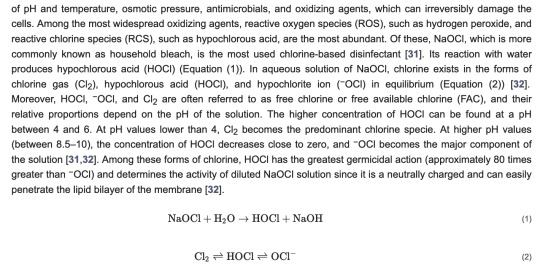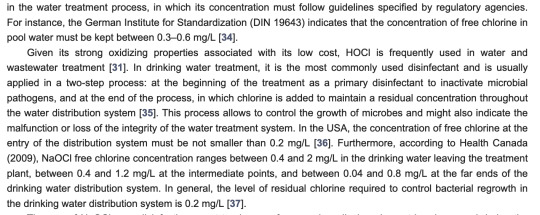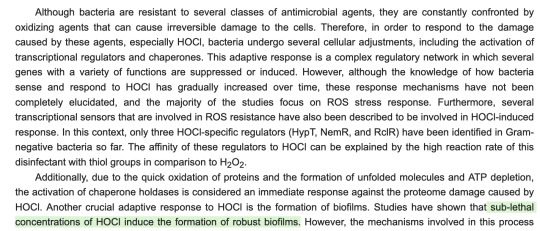#Sodium Hypochlorite
Text

Because chlorine fumes are purely a bitch on sinuses!
13 notes
·
View notes
Text

https://amzn.to/47BXqH6
About this item
Formulated with 96.3% Snail Secretion Filtrate, this moisturiser protects the skin from dryness and aging by repairing the skin's moisture. This snail serum improves the skin's vitality by reducing dullness and soothing dehydrated skin with snail mucin.
Our Advanced Skin Snail Essence features a lightweight texture that immediately seeps in to the skin upon application and delivers multiple effects. The snail essence will leave your skin hydrated and with a healthy glow.
Snail 96 Mucin Essence contains 96% Snail Mucin, which helps repair and soothe red, sensitized skin after breakouts by replenishing moisture deep into your skin while also improving skin elasticity. *Highly recommended for dehydrated and damaged skin.
Snail Mucin is obtained in a safe and environmentally friendly way in a favorite environment of snails and then processed as a cosmetic material. 100% Natural, Hypoallergenic, Dermatologist-tested.
Caution: If you have experienced allergic/ negative reactions to skincare products in the past, we highly recommend performing a patch test of the product on less sensitive areas of your body such as your arm or leg before applying on the face.
1 note
·
View note
Link
Sodium Hypochlorite Supplier Mena
#Sodium Hypochlorite Supplier Saudi Arabia#sodium hypochlorite#sodium hypochlorite manufacturer mena#Chemical manufacturing companies Saudi Arabia
0 notes
Link
Caustic soda (sodium hydroxide) is a versatile alkali. This white solid ionic compound comprises sodium cations Na+ and hydroxide anions OH-. Chemstock is among the most renowned and reliable Sodium Hydroxide Suppliers in UAE and offers you a premium grade of this product. Top providers of Sodium Hypochlorite UAE typically prepare caustic soda flakes with the help of a process called electrolysis of sodium chloride using membrane cell technology.
Applications and use of Caustic Soda Solution
Being one of the leading, Caustic Soda Suppliers in UAE Chemstock offers this alkali solution for diverse applications and usage. Here are some of the major ones:
Caustic Soda is used typically in the form of lye for the purpose of removing the lignin that tends to bind the fibers in the chemical pulping process when it comes to the pulp and paper industry. Sodium hydroxide is also used for the paper recycling process. Paper fibers usually swell when they are placed in a solution along with the sodium hydroxide. This swelling helps subsequently aids in separating the ink that is attached to the fibers, thereby allowing the fibers to be reused. As one of the top suppliers of Caustic Soda, Chemstock offers perfect solutions for the pulp and paper industry.
For the refining of Edible Oil, Sodium Hypochlorite UAE can be used as a neutralizer in order to rid them of free fatty acids that provide an unpleasant taste to the oils.
As major UAE Caustic Soda Suppliers, our offerings can be used in the petroleum processing industry (refineries). Usually, caustic soda is used there as alkalinity sources in the liquid scrubbing of Sulphur dioxide in flue gases produced from crude-oil-fired steam generators. These generators are additionally used for thermally enhanced oil recovery. Caustic soda is known to allow the SO2 scrubber to run at a lower pH with a higher SO2 removal capacity. Such a process is referred to as desulfurization.
Being major caustic soda UAE Suppliers, we also cater to the mining and refining industry, especially in terms of aluminum production. Alumina is basically produced from bauxite, which is an ore mined from topsoil in discerning subtropical and tropical regions with the usage of the Bayer process. As the bauxite is crushed, dried and washed, it ends up being dissolved with caustic soda at high temperatures in order to extract alumina in the form of sodium illuminate. This ultimately goes through a distinctive multi stage process in order to form Aluminum.
Caustic is considered to be a powerful means for pH adjustments and neutralization of water streams in water treatment plants. In certain cases, Sodium hydroxide is used during the water treatment process in order to raise the pH of water supplies.
Caustic Soda Solution offered by us is commonly used as an industrial cleaning agent, especially when it comes to the sterilization and cleaning of bottles in the beverage industry.
Being a reagent in chemical processing, Sodium Hypochlorite UAE tends to serve as a reactive agent in the production process. It helps deliver sodium to the final product, which has several applications. Caustic soda is used in the production of phosphates, silicates, bleach, fiber and more.
#Soda Ash#Caustic Soda#Isopropyl Alcohol#Sodium Hypochlorite#Caustic Soda Suppliers in Uae#Sodium Hypochlorite Uae#Soda Ash Suppliers in Uae
0 notes
Photo





Surviving Reactive Chlorine Stress: Responses of Gram-Negative Bacteria to Hypochlorous Acid
0 notes
Text
Sodium Hypochlorite Prices Analysis, Tracking, Updates, Trends & Forecast | ChemAnalyst

Sodium hypochlorite prices, reflecting the cost of this chemical compound, are subject to fluctuations influenced by various factors such as global market dynamics, industrial demand, and production costs. Understanding these price movements entails a comprehensive analysis of supply and demand dynamics, raw material availability, and macroeconomic indicators.
The pricing of sodium hypochlorite is significantly influenced by the balance between supply and demand within industries such as water treatment, sanitation, and disinfection. Sodium hypochlorite, valued for its properties as a disinfectant and bleach, finds extensive application in products ranging from household cleaners and swimming pool treatments to municipal water treatment and industrial disinfection processes. Disruptions in the supply chain, such as fluctuations in raw material availability, production capacity, or transportation logistics, can impact the availability and cost of sodium hypochlorite, thereby influencing its market price.
Industrial demand plays a crucial role in determining sodium hypochlorite prices. Industries such as water treatment and sanitation rely heavily on sodium hypochlorite for its role in disinfecting and purifying water, wastewater, and surfaces. Fluctuations in demand from these sectors, influenced by factors such as population growth, urbanization, and public health concerns, can lead to price volatility for sodium hypochlorite.
Get Real-Time Sodium Hypochlorite Prices: https://www.chemanalyst.com/Pricing-data/sodium-hypochlorite-1560
Raw material costs significantly impact sodium hypochlorite prices. The price of raw materials such as chlorine gas and caustic soda, which are used in sodium hypochlorite production, can fluctuate due to changes in global supply and demand dynamics, chemical prices, and energy costs. Any significant increase in raw material costs can translate into higher production costs for sodium hypochlorite manufacturers, thereby exerting upward pressure on prices.
Macroeconomic indicators, such as GDP growth, infrastructure investments, and healthcare expenditures, can indirectly affect sodium hypochlorite prices by influencing overall demand for products containing sodium hypochlorite. Economic expansions tend to drive demand for sodium hypochlorite-intensive products such as water treatment chemicals, disinfectants, and cleaning agents, thereby supporting higher prices. Conversely, economic downturns or uncertainties may lead to reduced demand and downward pressure on sodium hypochlorite prices.
Regulatory changes and quality standards also play a role in shaping sodium hypochlorite prices. Government regulations on water quality, sanitation standards, and chemical safety can impact production costs and market access for sodium hypochlorite manufacturers. Compliance with these regulations may require investments in technology upgrades, environmental controls, and quality assurance measures, influencing pricing dynamics.
Looking ahead, several factors are expected to continue influencing sodium hypochlorite prices. Continued emphasis on water quality, public health, and sanitation, coupled with increasing regulatory scrutiny and environmental concerns, is likely to drive sustained demand for sodium hypochlorite. Moreover, advancements in disinfection technology, changes in consumer preferences, and shifts in global supply chains could lead to changes in market dynamics and price levels for sodium hypochlorite.
In conclusion, sodium hypochlorite prices are subject to a complex interplay of factors including supply and demand dynamics, industrial trends, raw material costs, regulatory changes, and macroeconomic indicators. Stakeholders in industries reliant on sodium hypochlorite, such as water treatment, sanitation, and disinfection, must closely monitor these factors to anticipate price movements and make informed decisions. As industries evolve and regulatory requirements evolve, navigating the dynamic landscape of sodium hypochlorite pricing will remain a key challenge for industry participants.
Get Real-Time Sodium Hypochlorite Prices: https://www.chemanalyst.com/Pricing-data/sodium-hypochlorite-1560
ChemAnalyst
GmbH — S-01, 2.floor, Subbelrather Straße,
15a Cologne, 50823, Germany
Call: +49–221–6505–8833
Email: [email protected]
Website: https://www.chemanalyst.com
0 notes
Text
#Sodium Hypochlorite Pricing Report 2024#Sodium Hypochlorite pricing chart#Sodium Hypochlorite price news
0 notes
Text
Sodium Hypochlorite Price, News, Monitor, Supply & Demand, Forecast | ChemAnalyst

The Sodium Hypochlorite prices have experienced notable fluctuations in recent times, driven by a combination of factors that encompass supply chain dynamics, global demand shifts, and external influences. This essential chemical compound, commonly known as bleach, plays a pivotal role in various industries, including water treatment, healthcare, and household cleaning. The market is highly responsive to changes in raw material costs, transportation expenses, and regulatory developments.
One of the primary determinants of Sodium Hypochlorite prices is the availability and pricing of its key raw material, chlorine. Chlorine is a critical component in the manufacturing process of Sodium Hypochlorite, and any fluctuations in its supply or pricing can have a direct impact on the final product's cost. The market's sensitivity to chlorine prices underscores the importance of monitoring the chlorine market trends for a comprehensive understanding of Sodium Hypochlorite pricing dynamics.
Global demand for Sodium Hypochlorite has experienced notable shifts, with increased emphasis on water treatment applications. The growing awareness of the need for clean and safe water sources has led to a surge in demand for Sodium Hypochlorite in water treatment plants globally. Moreover, the ongoing emphasis on hygiene and disinfection, especially in the wake of the COVID-19 pandemic, has further bolstered demand in healthcare and household cleaning sectors. As these industries expand, the Sodium Hypochlorite market witnesses increased demand, influencing prices accordingly.
The intricate web of the Sodium Hypochlorite supply chain also plays a crucial role in determining market prices. Factors such as transportation costs, storage facilities, and distribution networks contribute to the overall cost structure. Global economic conditions, geopolitical events, and natural disasters can disrupt the supply chain, leading to short-term spikes or declines in Sodium Hypochlorite prices. Market participants need to remain vigilant and adaptable to these external factors to navigate the inherent uncertainties in the industry.
Get Real Time Prices of Sodium Hypochlorite: https://www.chemanalyst.com/Pricing-data/sodium-hypochlorite-1560
Regulatory developments and environmental considerations further contribute to the Sodium Hypochlorite market's price dynamics. As governments worldwide implement stricter regulations on chemical manufacturing and usage, compliance with environmental standards becomes a significant cost factor for Sodium Hypochlorite producers. The need to invest in sustainable and eco-friendly production processes may impact the overall cost structure, influencing market prices accordingly. Market participants must stay abreast of evolving regulatory landscapes to anticipate and adapt to potential shifts in the Sodium Hypochlorite market.
In recent years, the Sodium Hypochlorite market has witnessed a gradual shift towards sustainable practices. The industry is exploring alternative production methods and raw materials to reduce its environmental footprint. This transition, while essential for long-term sustainability, may initially pose challenges and impact market prices as companies invest in research, development, and implementation of these eco-friendly practices.
The Sodium Hypochlorite market is also influenced by broader economic trends. Economic downturns can lead to reduced industrial activities and consumer spending, affecting demand for Sodium Hypochlorite across various applications. Conversely, periods of economic growth can stimulate demand, leading to increased market prices. Understanding the macroeconomic factors that influence the Sodium Hypochlorite market is crucial for industry participants to make informed decisions and navigate market fluctuations effectively.
In conclusion, the Sodium Hypochlorite market is a complex and dynamic environment where prices are shaped by a multitude of factors. From raw material costs and global demand trends to supply chain dynamics, regulatory developments, and environmental considerations, market participants must analyze a plethora of variables to comprehend the pricing landscape fully. Navigating the Sodium Hypochlorite market requires a combination of strategic foresight, adaptability, and a comprehensive understanding of the interconnected factors that contribute to price fluctuations in this critical chemical sector.
Contact Us:
ChemAnalyst
GmbH - S-01, 2.floor, Subbelrather Straße,
15a Cologne, 50823, Germany
Call: +49-221-6505-8833
Email: [email protected]
Website: https://www.chemanalyst.com
0 notes
Text
Simplify your shopping experience with our online platform and bring the power of professional-grade dental care to your fingertips. Purchase Septodont Parcan Sodium Hypochlorite 5, 500ml, and take a significant step towards enhancing your dental practice today!
0 notes
Text
bleach fumes making me see shrimp colours

#i should probably open the window. but then my flat will get cold.#transcending to the astral plane on a boat of sodium hypochlorite
1 note
·
View note
Link
#sodium hypochlorite market#sodium hypochlorite#chemical company saudi arabia#sodium hypochlorite supplier saudi arabia
0 notes
Link
Sodium hypochlorite, more commonly referred to as bleach, is quite frequently used as a disinfecting agent. Chemstock is among the most well-established sodium hypochlorite suppliers in UAE, and our offerings are effective for the disinfection of viruses, bacteria, fungi, and mycobacterium.
Sodium Hypochlorite Solution essentially is a slightly yellow or colorless watery liquid that has an odor quite similar to that of the typical household bleach, and is produced by the reaction of chlorine and sodium hydroxide. Over the years, it has emerged as a cost-effective method for preventing the spread of infections through diverse water-borne diseases.
Chemstock: A reliable Sodium Hypochlorite Supplier
We at Chemstock offer high-quality sodium hypochlorite UAE, which can be used for multiple applications and by diverse industries. Through us, you can purchase Sodium hypochlorite in diverse concentrations of 6% to 15%. Our products are always transported by taking into consideration the needed safety concerns. Typically, we use plastic drums, bulk road tankers, intermediate bulk containers (IBCs), or cans of various sizes to transport Sodium Hypochlorite Solution to our customers.
The prime characteristics of sodium hypochlorite
Sodium hypochlorite has a relative density of is 1,1. This makes it a 5,5% watery solution.
Bleaching agents meant for domestic usage typically feature 5% sodium hypochlorite, with a pH of around 11. As a leading provider of Sodium Hypochlorite Solution supply, we at Chemstock offer a more concentrated version that is ideal for discerning industrial applications. Our products can have a concentration of 10-15% sodium hypochlorite with a pH of around 13.
Sodium hypochlorite is unstable, and can degenerate if it comes in contact with acids, sunlight, certain metals and corrosive gasses. It also reacts with flammable compounds and redactors, and is an inflammable product. As one of the major sodium hypochlorite suppliers in UAE, we keep all these factors in mind when it comes to the transportation and storage of sodium hypochlorite. We always make sure that our product safely reaches our customers, and hence utilize an extremely systematic packaging and transit process.
Why buy sodium hypochlorite UAE?
According to several investigations, sodium hypochlorite has emerged as quite an effective disinfectant that has a broad range of applications. In comparison to many other popular disinfectants like ozone, UV solar disinfection and calcium hypochlorite, as well as treatment processes like filters, slow sand filtration, sodium hypochlorite tends to provide the ideal mix of ease of usage, low cost, safety and high-effectiveness in regions where water is not highly turbid. Its advantageous features make it ideal for use in several UAE industries, especially when it comes to water disinfection.
0 notes
Text
When sodium hypochlorite (bleach) solution is added to luminol, a chemical reaction occurs that releases energy in the form of light. This is called chemiluminescence. The bleach solution acts as an oxidizing agent, which means it takes electrons away from the luminol molecule. This causes the luminol molecule to become excited, and it releases the energy as light.
🎥 Courtesy: Kendra Frederick
The luminol molecule is made up of two amino groups, a carbonyl group, and an azo group. The amino groups are electron-rich, while the carbonyl group is electron-poor. The azo group is a conjugated system, which means that the electrons in the double bonds can move freely from one atom to another.
When sodium hypochlorite (bleach) solution is added to luminol, the bleach molecules react with the amino groups of the luminol molecule. This reaction takes electrons away from the luminol molecule, which causes the luminol molecule to become oxidized. The oxidized luminol molecule is in an excited state, which means that it has more energy than it normally does.
The excited luminol molecule then releases the extra energy as light. This light is called chemiluminescence. The light emitted by the chemiluminescence reaction is blue because the luminol molecule has a blue fluorescence.
The chemiluminescence reaction between luminol and sodium hypochlorite is catalyzed by the presence of a metal ion, such as iron or copper. The metal ion helps to stabilize the excited state of the luminol molecule, which makes it more likely to release the extra energy as light.
The chemiluminescence reaction is very sensitive to impurities, so it is important to use pure chemicals. The reaction can also be affected by the pH of the solution. The optimal pH for the reaction is around 9.
The chemiluminescence reaction between luminol and sodium hypochlorite can be used to detect blood, as the iron in hemoglobin can catalyze the reaction. The reaction is also used in some commercial products, such as glow sticks and emergency lights.
I hope you enjoyed learning about this. ❤️🙏
#chemiluminescence#luminol#bleach#science#chemistry#scienceexperiment#glowing#light#excitedstate#oxidation#chemicalreact
5K notes
·
View notes
Text
Sodium Hypochlorite Prices Trend, Monitor, News & Forecast | ChemAnalyst

Sodium hypochlorite prices have undergone fluctuations influenced by various factors, including global market dynamics, industrial demand, and production costs. Understanding these price movements requires a comprehensive analysis of supply and demand dynamics, regulatory changes, and macroeconomic indicators.
One of the primary drivers affecting sodium hypochlorite prices is the balance between supply and demand within the chemical industry. Sodium hypochlorite, a chemical compound commonly used as a disinfectant, bleaching agent, and water treatment chemical, is essential in various sectors including healthcare, sanitation, and municipal water treatment. Disruptions in the supply chain, such as fluctuations in raw material availability or production capacity, can impact the availability and cost of sodium hypochlorite, thereby influencing its market price.
Industrial demand plays a pivotal role in determining sodium hypochlorite prices. The healthcare sector, water treatment facilities, and commercial cleaning companies are major consumers of sodium hypochlorite, using it for disinfection purposes. Fluctuations in demand from these sectors, influenced by factors such as public health emergencies, regulatory changes, and seasonal variations, can lead to price volatility for sodium hypochlorite.
Get Real Time Sodium hypochlorite prices: https://www.chemanalyst.com/Pricing-data/sodium-hypochlorite-1560
Raw material costs significantly influence sodium hypochlorite prices. The price of raw materials such as chlorine gas and sodium hydroxide, which are used in sodium hypochlorite production, can fluctuate due to changes in global supply and demand dynamics, energy costs, and currency fluctuations. Any substantial increase in raw material costs can translate into higher production costs for sodium hypochlorite manufacturers, thereby exerting upward pressure on prices.
Macroeconomic indicators, such as GDP growth, inflation rates, and currency exchange rates, can indirectly impact sodium hypochlorite prices by affecting overall industrial activity and consumer spending. Economic downturns or currency devaluations in major sodium hypochlorite-consuming regions may lead to decreased demand and downward pressure on prices. Conversely, robust economic growth and stable currencies can support higher prices for sodium hypochlorite by stimulating demand for disinfection and sanitation products.
Regulatory changes and quality standards also play a role in shaping sodium hypochlorite prices. Government regulations on water quality, sanitation standards, and chemical safety can impact production costs and market access for sodium hypochlorite manufacturers. Compliance with these regulations may entail investments in technology and process improvements, which could influence pricing dynamics.
Looking ahead, several factors are expected to continue influencing sodium hypochlorite prices. Continued growth in sectors such as healthcare, sanitation, and water treatment, particularly in regions with growing populations and increasing urbanization, is likely to drive sustained demand for sodium hypochlorite. Moreover, advancements in disinfection technologies and public health initiatives could lead to changes in market dynamics and price levels for sodium hypochlorite.
In conclusion, sodium hypochlorite prices are subject to a complex interplay of factors including supply and demand dynamics, industrial trends, raw material costs, regulatory changes, and macroeconomic indicators. Stakeholders in the chemical and sanitation industries must closely monitor these factors to anticipate price movements and make informed decisions. As public health concerns evolve and sanitation standards become increasingly stringent, navigating the dynamic landscape of sodium hypochlorite pricing will remain a key challenge for industry participants.
Get Real Time Sodium hypochlorite prices: https://www.chemanalyst.com/Pricing-data/sodium-hypochlorite-1560
ChemAnalyst
GmbH — S-01, 2.floor, Subbelrather Straße,
15a Cologne, 50823, Germany
Call: +49–221–6505–8833
Email: [email protected]
Website: https://www.chemanalyst.com
0 notes